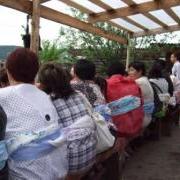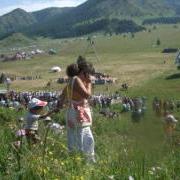Project Year
2009
Region(s)
Central Asia
Country(ies)
Altai Republic, Russia
Project Description
The project aims to study the social practices and relationships involving money and non-monetary objects used as money or in exchange for money among contemporary Altaians, semi-nomadic pastoralists in the remote Altai province on the Russian side of the Mongolian border. Despite socio-economic modernization, which started in the 19th century and intensified during the Soviet period, livestock continues to maintain a dominant position today. Farming, hunting, and gathering provide Altaians with additional resources. According to official statistics in 2008, monthly wages in agriculture in the Altai Republic was three thousand rubles or about $100. Almost 90% of unemployed residents of the Altai Republic are rural dwellers. Thus, the vast majority of Altaians live in poverty. Despite this, a significant number of Altai villagers use mobile phones, one of the uses being to activate credit cards with commercial banks to get cash. This study seeks to document ethnographically daily life among the Altaians: living in villages, working in schools, health facilities and other institutions, as well as the unemployed and pensioners, as they begin to participate in a monetized economy.
Researcher(s)
Svetlana Tyukhteneva
About the Researcher(s)

Svetlana Tyukhteneva graduated with an MA in history from Altai State University, Department of Archaeology and Ethnology, Faculty of History, Russia in 1989. She received her PhD in Ethnography, Ethnology and Anthropology, Center for Asia and Oceania Studies, Institute for Ethnology and Anthropology of RAS, Moscow, Russia in 1996. She is currently at the same Institute, continuing to explore the culture of Altai. She is the author of two books (one co-authored), has written more than 50 publications in journals and collections of articles, and is an expert of the Network for Ethnic Monitoring and early warning of conflicts in the Republic of Altai.
Synopsis of Research Results
 The Altai Republic of the Russian Federation is located in the south of Western Siberia,
along the Russian border with Kazakhstan, China and Mongolia. Its population is about
211,000 people, who occupy 243 rural villages and one city. Seventy-four percent life
in rural areas. People are farmers and herders, with cattle being the primary source
of income and store of value. Pine nuts are an important export; they are collected
and sold to brokers who sell them to processing plants in Russia and especially in
China. There is only one meat market, in the city of Gorno-Altaisk. There are no regular
produce markets. People grow forsubsistence and engage in some trading among themselves.
The Altai Republic of the Russian Federation is located in the south of Western Siberia,
along the Russian border with Kazakhstan, China and Mongolia. Its population is about
211,000 people, who occupy 243 rural villages and one city. Seventy-four percent life
in rural areas. People are farmers and herders, with cattle being the primary source
of income and store of value. Pine nuts are an important export; they are collected
and sold to brokers who sell them to processing plants in Russia and especially in
China. There is only one meat market, in the city of Gorno-Altaisk. There are no regular
produce markets. People grow forsubsistence and engage in some trading among themselves.
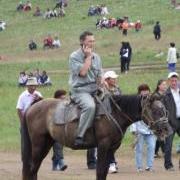 The research found that among Altaians money takes many forms: cattle (live animals
and meat), gold and silver jewelry, furs, cloth, and alcohol. Altaians use state-issued
paper bills and metal coins, as well as plastic bank cards, just like everyone else
in the world: to buy food and other essential goods, pay bills for electricity, water,
gas and taxes. But with coins they also make offerings to local spirits and masters,
and this practice is related to their ritual life. Different kinds of money are used
in different situations, usually during rites of passage. These include traditional
rituals associated with childbirth, weddings, funerals, and modern family celebrations
associated with duties in the army, or the obtaining a diploma.
The research found that among Altaians money takes many forms: cattle (live animals
and meat), gold and silver jewelry, furs, cloth, and alcohol. Altaians use state-issued
paper bills and metal coins, as well as plastic bank cards, just like everyone else
in the world: to buy food and other essential goods, pay bills for electricity, water,
gas and taxes. But with coins they also make offerings to local spirits and masters,
and this practice is related to their ritual life. Different kinds of money are used
in different situations, usually during rites of passage. These include traditional
rituals associated with childbirth, weddings, funerals, and modern family celebrations
associated with duties in the army, or the obtaining a diploma.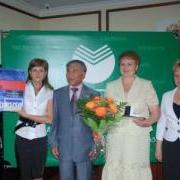
 1) State-issued currency in the form of paper and metal coins. In addition to the Russian ruble, Altaians
used the U.S. dollar and European euro for their savings. And, as a rule, from 2009
on they have used the ruble in bank deposits, and dollars and euros in cash kept in
the household. Debit cards have become more common with the cashless payment of wages
for some workers in the city. Typically, this is a plastic card with a chip from the
Savings Bank of Russia (“Sbercard”), and rarely cards of international systems Visa
and Maestro. Coins have ritual purposes, and one finds coins of many denominations
and from various countries left as offerings in streams and rocks by the roadside.
1) State-issued currency in the form of paper and metal coins. In addition to the Russian ruble, Altaians
used the U.S. dollar and European euro for their savings. And, as a rule, from 2009
on they have used the ruble in bank deposits, and dollars and euros in cash kept in
the household. Debit cards have become more common with the cashless payment of wages
for some workers in the city. Typically, this is a plastic card with a chip from the
Savings Bank of Russia (“Sbercard”), and rarely cards of international systems Visa
and Maestro. Coins have ritual purposes, and one finds coins of many denominations
and from various countries left as offerings in streams and rocks by the roadside.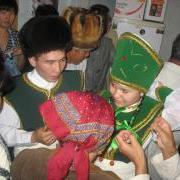 2) Vodka (alcohol) as the equivalent of money. “Half-liter” (otherwise known as kabak araki (tavern liquor), ack araki (“white liquor”) in Soviet and early post-Soviet era was a standard acceptable for
all services. Today, the system operates as before. People make oral agreements for
payment for agricultural work: digging a garden is 400 rubles (US$13) a day; mowing
hay is 500 rubles a day. A study of the cash needed to conduct life-cycle rituals
like a wedding found that over 60% of the amount is for the purchase of alcoholic
beverages. As a rule, for the wedding to buy at least 10 crates of vodka, 10 crates
of wine, beer (in a wooden box fits a standard 20 bottles of vodka a capacity of 0.5
liters, in a cardboard box - 12 bottles of the same volume.
2) Vodka (alcohol) as the equivalent of money. “Half-liter” (otherwise known as kabak araki (tavern liquor), ack araki (“white liquor”) in Soviet and early post-Soviet era was a standard acceptable for
all services. Today, the system operates as before. People make oral agreements for
payment for agricultural work: digging a garden is 400 rubles (US$13) a day; mowing
hay is 500 rubles a day. A study of the cash needed to conduct life-cycle rituals
like a wedding found that over 60% of the amount is for the purchase of alcoholic
beverages. As a rule, for the wedding to buy at least 10 crates of vodka, 10 crates
of wine, beer (in a wooden box fits a standard 20 bottles of vodka a capacity of 0.5
liters, in a cardboard box - 12 bottles of the same volume.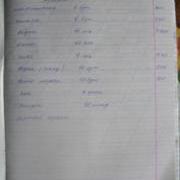 rubles), 7 boxes of beer (1120 rubles), 6 bottles of champagne (300 rubles), 5 bottles
of cognac (350 rubles), 10 bottles of expensive vodka and fine wines (500 rubles),
6 packs of juice and 10 liters of other alcohol. The alcoholic beverages were not
for drinking at the wedding: most was given to members of the family, relatives of
the organizers of the wedding who could not come, and for gifts to send home with
wedding guests. During the “stag and hen” ceremonies, which stylize courtship, alcohol
is conceptualized and articulated as the “price” of the girl. A person who has received
from the organizers of the wedding these gifts of alcohol treats it specially, upon
each occasion of its consumption telling one’s guests that the drink was obtained
after the change in status of the daughter of a certain family into a wife. Similar
to the North American potlatch of accumulation and consumption, the distribution of
alcohol creates social capital. In assessing weddings people say, “At the wedding
of _____ there was a lot of alcohol,” and this expression means that the wedding hosts
have very good relationships.
rubles), 7 boxes of beer (1120 rubles), 6 bottles of champagne (300 rubles), 5 bottles
of cognac (350 rubles), 10 bottles of expensive vodka and fine wines (500 rubles),
6 packs of juice and 10 liters of other alcohol. The alcoholic beverages were not
for drinking at the wedding: most was given to members of the family, relatives of
the organizers of the wedding who could not come, and for gifts to send home with
wedding guests. During the “stag and hen” ceremonies, which stylize courtship, alcohol
is conceptualized and articulated as the “price” of the girl. A person who has received
from the organizers of the wedding these gifts of alcohol treats it specially, upon
each occasion of its consumption telling one’s guests that the drink was obtained
after the change in status of the daughter of a certain family into a wife. Similar
to the North American potlatch of accumulation and consumption, the distribution of
alcohol creates social capital. In assessing weddings people say, “At the wedding
of _____ there was a lot of alcohol,” and this expression means that the wedding hosts
have very good relationships. 3) Animals are also equivalent to cash. The word “mal” in the Altaic language refers to both
livestock in general, and horses in particular. Mal in the sense of “cattle” is an
important economic concept and a customary legal term, as it covers both the main
spheres of Altaians (animal husbandry), as well as the main object of customary law
(livestock). Mal also has the sense of “ownership” and “property.” In the contemporary
Altaic language “livestock” implicitly contains the values of “money,” “property,”
“wealth,” “good,” and “food.” According Turkologist NA Baskakov “mal” was borrowed
from Arabic. In Arabic, the word means “money,” “property,” and “goods” but not “cattle.”
“Property” in the Altaic language eventually came to designate a wide range of concepts,
including values such as “pet,” “cattle,” “wealth,” “property,” “money,” “wild animal,”
the property of the spiritual masters of the landscape, and the sacrifice or offering
left in spirit areas. When the Altai people say about someone, that person has maldu-ashtu (a cattle-food), they imply that he or she also has a sufficient amount of money.
Typically, Altaians give animals to children at the completion of their first and
twelfth year of life, as well as a wedding gift. Giving cattle means giving potential, possible money that you can get in the future by selling the annual offspring of
cows, sheep or horses. Another important aspect of the concept of mal is the equivalence
and interchangeability of the soul of a man (the owner) and the soul of his horse.
Giving a man a horse recognizes his full personality and his potential to become the
owner of a large herd.
3) Animals are also equivalent to cash. The word “mal” in the Altaic language refers to both
livestock in general, and horses in particular. Mal in the sense of “cattle” is an
important economic concept and a customary legal term, as it covers both the main
spheres of Altaians (animal husbandry), as well as the main object of customary law
(livestock). Mal also has the sense of “ownership” and “property.” In the contemporary
Altaic language “livestock” implicitly contains the values of “money,” “property,”
“wealth,” “good,” and “food.” According Turkologist NA Baskakov “mal” was borrowed
from Arabic. In Arabic, the word means “money,” “property,” and “goods” but not “cattle.”
“Property” in the Altaic language eventually came to designate a wide range of concepts,
including values such as “pet,” “cattle,” “wealth,” “property,” “money,” “wild animal,”
the property of the spiritual masters of the landscape, and the sacrifice or offering
left in spirit areas. When the Altai people say about someone, that person has maldu-ashtu (a cattle-food), they imply that he or she also has a sufficient amount of money.
Typically, Altaians give animals to children at the completion of their first and
twelfth year of life, as well as a wedding gift. Giving cattle means giving potential, possible money that you can get in the future by selling the annual offspring of
cows, sheep or horses. Another important aspect of the concept of mal is the equivalence
and interchangeability of the soul of a man (the owner) and the soul of his horse.
Giving a man a horse recognizes his full personality and his potential to become the
owner of a large herd.